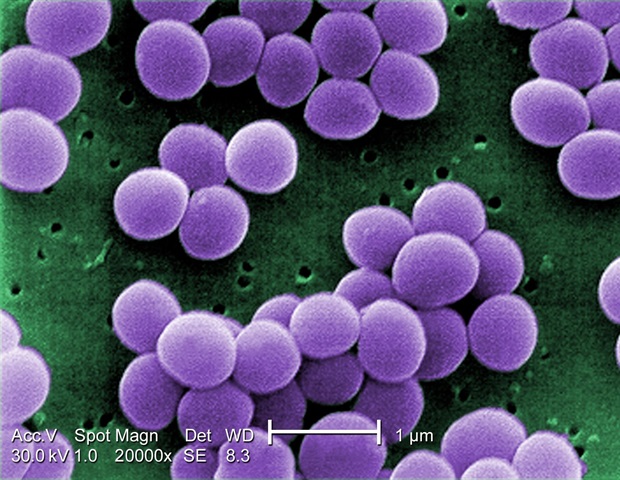The most detailed study to date on the mechanisms by which a common type of bacterium, Staphylococcus aureus, adapts to living on the human body could help improve the prevention, diagnosis, and treatment of certain infections.
The study, from the Wellcome Sanger Institute, the University of Cambridge, the Institute of Biomedicine of Valencia (IBV) at the Spanish National Research Council (CSIC) and their collaborators, involved using the genomes of thousands of S. aureus isolates cultured from the human nose and on the skin to investigate which genes are important for the bacteria to adapt and persist.
Published today (13 January) in Nature Communications, they used a new approach of analysing the genomes of bacteria from human carriers, to highlight exactly how these bacteria adapt in their natural habitat. This revealed key mutations that enable certain strains to evade the human immune system and become resistant to antibiotics.
This large-scale genetic analysis uncovered several genes and biological pathways that were not previously known to be involved in S. aureus colonisation.
Further investigation is now required to fully understand the role these play in human colonisation, and if there is a way to target these pathways in the future to help prevent, diagnose or treat infections caused by S. aureus.
Bacteria are commonly found in or on the body without causing harm, known as colonisation. One of these is S. aureus, a common type of bacteria that can be found in the nose of up to 30 per cent of the population worldwide as well as on the skin or in the intestine.
However, in those with a weakened immune system, S. aureus can get into the bloodstream and cause infections. These can range from mild skin and soft tissue infections to more severe infections, including sepsis and pneumonia.
This new study is the first time researchers have carried out a large-scale genetic analysis of S. aureus from samples of human carriers, instead of observing the bacteria in a laboratory setting.
The international team analysed the genomes of more than 7,000 S. aureus samples obtained from more than 1,500 human carriers to identify genetic changes that originated in the bacteria while it was in its natural environment. Through computational analysis, they were able to identify the recurrent genetic changes in the bacteria that could have contributed to survival during human colonisation.
The researchers identified changes in genes associated with nitrogen metabolism, suggesting that this is a key metabolic process necessary for the colonisation of humans by S. aureus. They also identified mutations in genes that could influence the way the bacteria interact with human cells and the immune system.
Researchers found that some S. aureus strains have mutations in genes that are involved with regulating the factors the bacteria use to escape the human immune system, possibly highlighting an immune system evasion strategy. Researchers also suggest that these bacterial strains might use factors secreted by other bacterial strains to colonise humans without producing these themselves – something they call ‘cheater’ cells.
Additionally, this study confirmed that S. aureus acquires resistance mutations to antibiotics such as fusidic acid, mupirocin, and trimethoprim.
Overall, this new research reveals key biological processes that S. aureus employs to survive in humans. The study of the evolution and genetic adaptation of bacteria in their natural environment, either during the asymptomatic colonization of their carriers or in the establishment and course of infections, can help improve the prevention, diagnosis, and treatment of disease.
Understanding how bacteria respond to antibiotic treatments has made it possible to identify the genetic changes that allow them to survive the attack of antibiotics. These mutations can be used as diagnostic markers, as well as to design new therapeutic strategies and a more rational and effective use of antibiotics. Studies of bacterial adaptation like this could also reveal mechanisms of immune evasion – how bacteria adapt to evade recognition and attack by our immune system. This could help identify new antigens, components of the bacteria that the immune system recognizes as foreign or dangerous, and design new vaccines.”
Dr. Francesc Coll, first author from the Institute of Biomedicine of Valencia at the Spanish National Research Council (CSIC)
Dr. Ewan Harrison, senior author from the Wellcome Sanger Institute, said: “While Staphylococcus aureus bacteria are harmless to many people, for others they can cause potentially life-threatening infections. Our study gives a detailed new understanding of how these bacteria adapt and evolve in order to survive on and in their human carriers at a genetic level. Through our new analysis, we were able to study these strains in their natural habitat; highlighting previously unknown mutations that give certain Staphylococcus aureus strains the upper hand. We hope that further investigation of the pathways we have uncovered will help improve the prevention, diagnosis, and treatment of infections caused by these bacteria.”
Source:
Journal reference:
Coll, F., et al. (2025) The mutational landscape of Staphylococcus aureus during colonisation. Nature Communications. doi.org/10.1038/s41467-024-55186-x.
Source link : News-Medica

